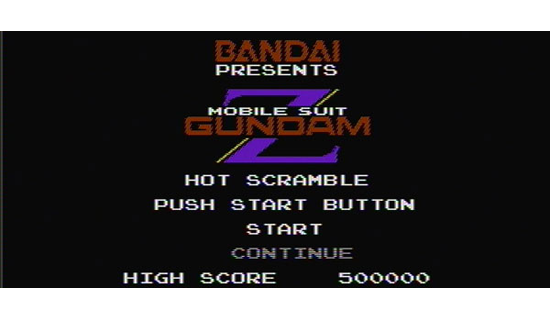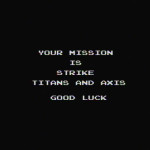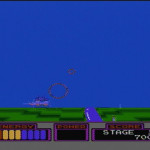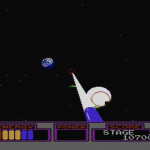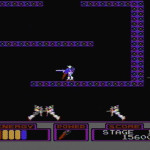In February of 1986 the Mobile Suit Zeta Gundam TV anime had just finished its fifty episode run of nearly one year in length. It received critical acclaim all around, garnered the highest ratings of any televised Gundam anime thus far and is widely regarded as one of Yoshiyuki Tomino’s (the creator of the Gundam franchise) best works. With Gundam fever spreading across Japan, it only made sense that the franchise should have a game on the Famicom.
Though this was the first Gundam game released on the Famicom, it was not the first Gundam game in general. The very first was on a system that Bandai themselves brought to Japan in 1983 called the Arcadia (the Japanese variant of the Emerson Arcadia 2001). A couple of others were also released on home computers such as the MSX and FM-7.
The Zeta Gundam plot is summed up with an opening story reel that’s strangely all in English. You’re piloting the Z Gundam (perhaps as Zeta Gundam main character Kamille Bidan, though that isn’t specifically mentioned) and taking on the Titans. The story reel isn’t shown until after the “EBI Warning” though, informing the player that they should most definitely not engage in acts of piracy. But even though the false warning is amazing in its own way, what may even be more amazing is the ridiculously detailed Mobile Suit bios that are shown afterward. They contain just about any piece of Mobile Suit data that an aficionado could want, including the weight of the Mobile Suit’s head. Combined with the chip tune version of the Zeta Gundam anime’s first theme song (“Zeta – toki wo koete”), this game has more of an anime-style intro than any other up to this point.
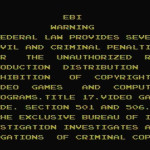 | 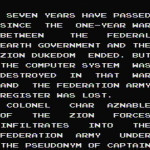 |
| The VIDEO GAME CODE says don’t pirate this game, okay?! It’s real, look it up! | The plot sounds ridiculous, but it’s a good show. I promise! |
Hot Scramble consists of two very different styles of gameplay: Cockpit view shooting (it’s really an FPS) and side-scrolling action shooting. The beginning of each level puts you inside of the Z Gundam’s cockpit on earth, where they are flying along the ground and shooting at other Mobile Suits with a beam rifle. You can also use the A button to accelerate your Mobile Suit, which seems to sometimes allow you to progress through levels faster than just shooting at everything you see. After destroying some key Mobile Suit types on Earth (the types themselves vary), a scene will take place in which the Z Gundam takes off into space. Once in space you’ll be treated to a starry background on which you’ll do the same thing that you did on Earth. The enemies seem to come much more fast and furiously here though. After a time there’s always a boss Mobile Suit or ship to be beaten that requires several blasts, all while it hammers you relentlessly with its own. A good hit and run tactic is required to make it through the space parts of each level with any measure of health.
You’re then suddenly taken from the now familiar first-person cockpit view to a third-person side scrolling view, completely changing the game’s dynamic. You control the Gundam through small labyrinths to find power ups (health, shields that prevent some damage, and a more powerful beam rifle) and shoot the enemy mobile suits that come at you from nearly every direction. An interesting mechanic to this portion of each level is that you have the choice to either walk or fly through the level (done by holding down A and specifying a direction in which to fly). This style of play will feel more familiar who’s played other Famicom/NES games of the time, so I found myself doing much better in these sections than I did in the first-person shooting sections. At the end you’ll have to fight what’s probably the base’s core. The Mobile Suit sprites are quite well drawn here, and we’re also treated to another chip tune rendition of Zeta Gundam’s second opening theme song, “mizu no hoshi e ai wo komete” throughout these levels.
This pattern continues for 16 stages, with things like enemy Mobile Suits, background colors of the areas and the layouts of the third-person labyrinths changing each time. After the 16th stage is completed, the levels begin to loop over from the beginning. However, unlike many of the arcade-y high-score focused games of old, there’s still a way to see an ending: You have to die after completing the 16th stage for an ending credit sequence with Fa Yuiry and Haro running and bouncing across the top of the screen.
Director Masanobu Endou (Creator of hits such arcade hits as Xevious and Tower of Druaga) worked closely with the rest of the team on the game out of a desire to create a good Gundam game. Endou had originally planned on making a version of the game that just involved the first-person shooting levels. He felt that moving about strategically and searching for/shooting at the enemy had a distinctly more New Type feeling to it by requiring the ability to think ahead of what was immediately happening. The game was tested with grade school children, but they were unable to grasp the very points that Endou thought made the game so interesting. As a result of this feedback, the development team decided to adopt some of the side-scrolling game play found in other popular Famicom games of the day, such as The Goonies. The first-person shooting sections were also made slightly easier.
This will probably not be the last time that I agree with Japanese elementary school students. Maybe it’s because of my distinct lack of experience and interest with the first-person shooter genre in general, but I found those parts of Hot Scramble to be much more frustrating than the side-scrolling parts. There was nothing particularly great about the side-scrolling sections, but I was able to bask in the fact that pattern memorization got you through the boss encounters with little to no effort whatsoever.
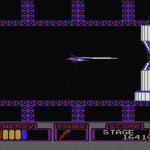 | 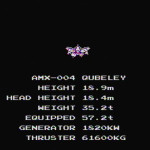 |
| The only logical thing to do at the end of some fortress is to destroy the core, obviously. | Everyone loves the Qubeley! |
This original version of the game had still been produced in limited quantities for testing purposes. Endou referred to this original version internally as “Product Z”, and decided to raffle off 1000 copies under the title “Mobile Suit Z Gundam – Hot Scramble Final Version”. Since there were a very limited number of these, gold cartridges are not easy to find and demand a ridiculously high price tag. Judging from playthroughs of the Final Version, it has a different HUD that feels more like being in a Mobile Suit cockpit, not featuring colorful energy bars and nicely labeled displays.
Hot Scramble has many descendants in the world of Gundam video games, and they come in many different varieties. Amidst all of these, the one thing that Hot Scramble retains is its originality. There weren’t many licensed games this early in console gaming history that strived to be as much as Hot Scramble was, and maybe that’s why it remains a franchise classic and interesting piece of gaming history.
